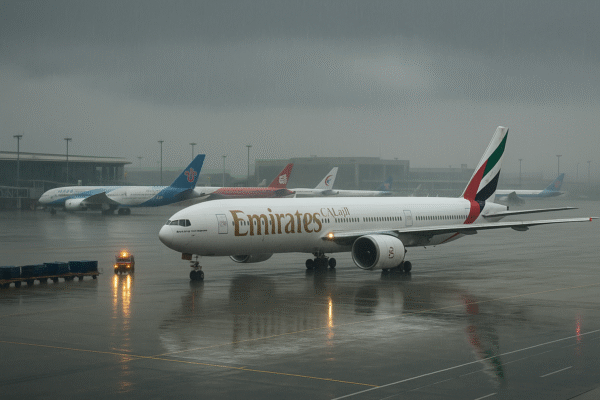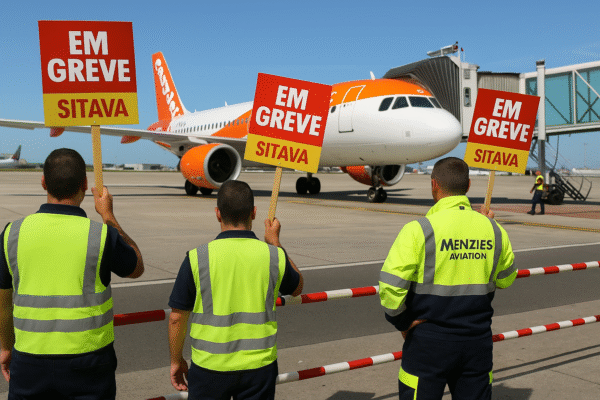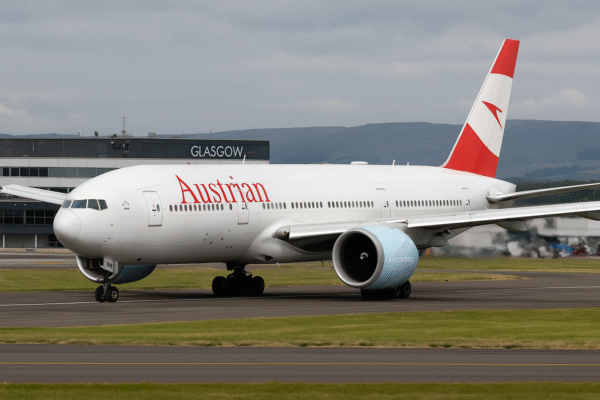Austrian Airlines Flight OS87, en route from Vienna to New York’s John F. Kennedy International Airport, made an unscheduled emergency landing in Glasgow on Wednesday, August 6, 2025, following a critical medical emergency onboard. The sudden diversion mid-flight highlights the challenges airlines face when dealing with health crises at 35,000 feet—and the professionalism required to respond swiftly.
Flight OS87 Diverted Mid-Atlantic Due to Medical Incident
Approximately halfway into the transatlantic journey, the flight crew of Austrian Airlines OS87 declared a code 7700—a universal aviation emergency signal—after a passenger fell seriously ill. The pilot quickly diverted the aircraft to Glasgow Airport, deemed the nearest suitable airport equipped to handle a medical emergency.
This decision, made in alignment with international aviation regulations, emphasized the airline’s prioritization of passenger welfare over timeliness. The aircraft landed safely at Glasgow Prestwick Airport, where emergency services were already on standby to assist the ailing passenger.
Emergency Protocols Activated In-Flight
Austrian Airlines confirmed that the onboard team activated their emergency medical response protocols immediately. Flight attendants, trained in first aid and crisis handling, were the first responders, coordinating care and preparing for the landing. While the airline has not disclosed the nature of the medical incident, sources confirm that the passenger required urgent treatment unavailable mid-flight.
In such high-pressure situations, every minute counts. With no doctors officially stationed on commercial flights, cabin crews often rely on telemedicine consultations with ground-based medical professionals to guide decisions. On OS87, the swift action of the flight crew ensured the passenger received medical attention within the shortest possible time.
Glasgow Airport Responds Efficiently
Glasgow Airport, one of Scotland’s busiest international hubs, handled the emergency landing seamlessly. Airport fire and rescue units, paramedics, and security staff coordinated with the Austrian Airlines crew to receive the aircraft and transfer the ill passenger for further medical attention.
Reports from fellow travelers indicate that the incident was handled calmly. Passengers expressed appreciation for the crew’s clear communication and professionalism during the diversion.
The delay, although inconvenient, was understood by most passengers as a necessary measure. After about two hours on the ground, during which medical and security protocols were completed, the flight resumed its journey to New York City, landing at JFK later than scheduled.
Impact on Travelers and Flight Scheduling
Though the emergency did not cause mass cancellations, the diversion did lead to disruptions in scheduling, particularly for connecting passengers. Austrian Airlines worked to provide assistance, rescheduling missed onward flights and compensating affected travelers according to EU261 regulations governing passenger rights.
Flight OS87’s delay serves as a reminder of the importance of flexibility and understanding when unforeseen medical events occur in flight. Most major airlines—including Austrian—provide channels for real-time updates and customer support in such situations.
Aviation Industry Focuses on Medical Preparedness
This incident reignites discussions in the aviation sector around onboard medical readiness. According to the International Air Transport Association (IATA), there are thousands of medical emergencies annually on commercial flights. The majority are handled without incident, but some require diversions.
Most airlines are equipped with emergency medical kits and automated external defibrillators (AEDs), and crew members undergo recurring training. However, as long-haul travel becomes more common among older and medically vulnerable populations, the need for advanced preparedness grows.
Experts suggest expanding the availability of telemedicine during flights and increasing awareness around pre-flight medical assessments for at-risk passengers.
Glasgow’s Role as a Strategic Diversion Hub
Strategically located, Glasgow Prestwick and Glasgow International airports frequently serve as diversion points for transatlantic flights facing emergencies. Their location between the U.S. and mainland Europe makes them ideal for quick access in mid-ocean medical or technical scenarios.
Scottish airport authorities praised the cooperation with Austrian Airlines and confirmed that operations resumed with minimal interruption.
Conclusion: Safety First in Global Aviation
Austrian Airlines’ emergency landing in Glasgow serves as a case study in the importance of rapid response and international cooperation in aviation safety. The successful outcome—a stabilized medical situation, safe landing, and eventual continuation of travel—demonstrates the value of strict safety protocols, trained personnel, and responsive airport infrastructure.
As global air travel increases, so does the unpredictability of in-flight health events. For travelers, incidents like OS87 highlight the critical role airline staff play in safeguarding lives—even at cruising altitude.
Travelers are reminded to carry necessary medications, inform airlines of any pre-existing conditions if needed, and follow all health-related travel advisories.
For future passengers boarding long-haul flights, Austrian Airlines’ handling of Flight OS87 is a reassuring testament that even in times of crisis, safety remains the airline industry’s top priority.
For more travel news like this, keep reading Global Travel Wire

















